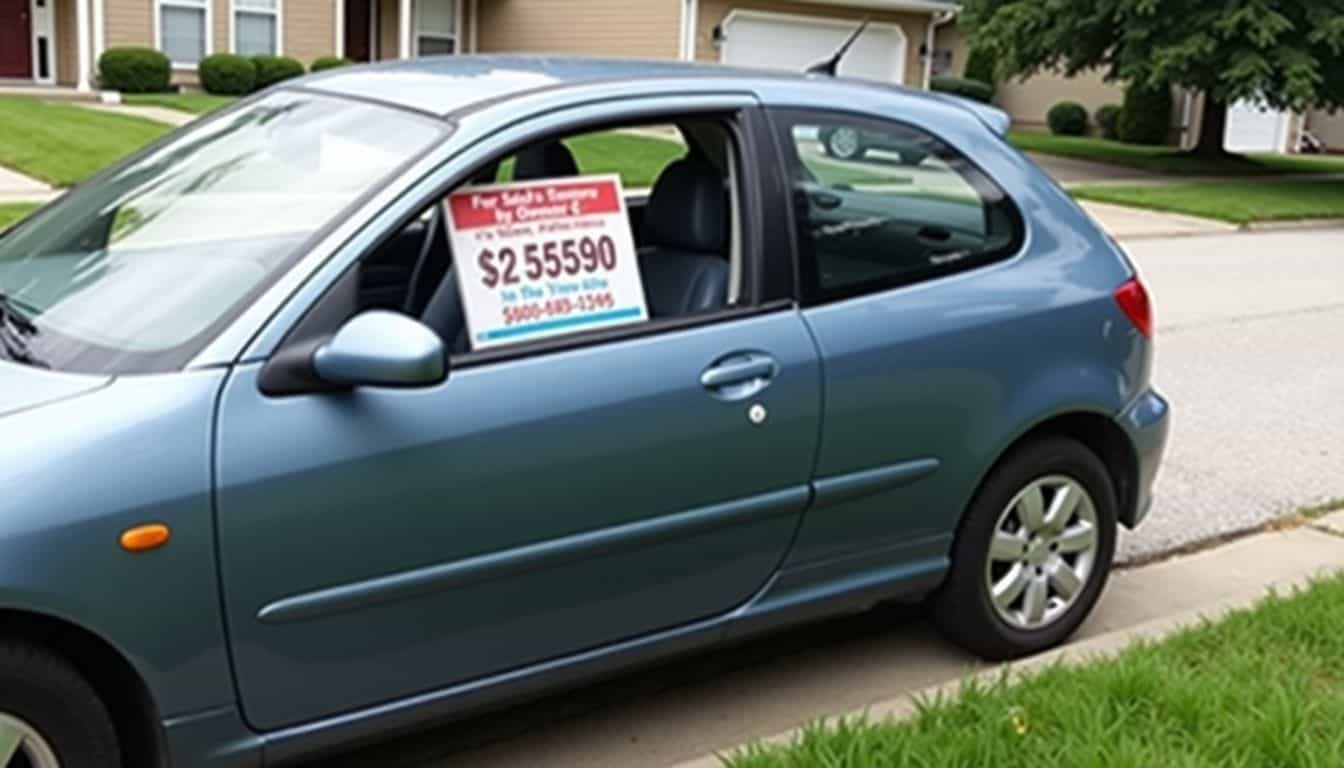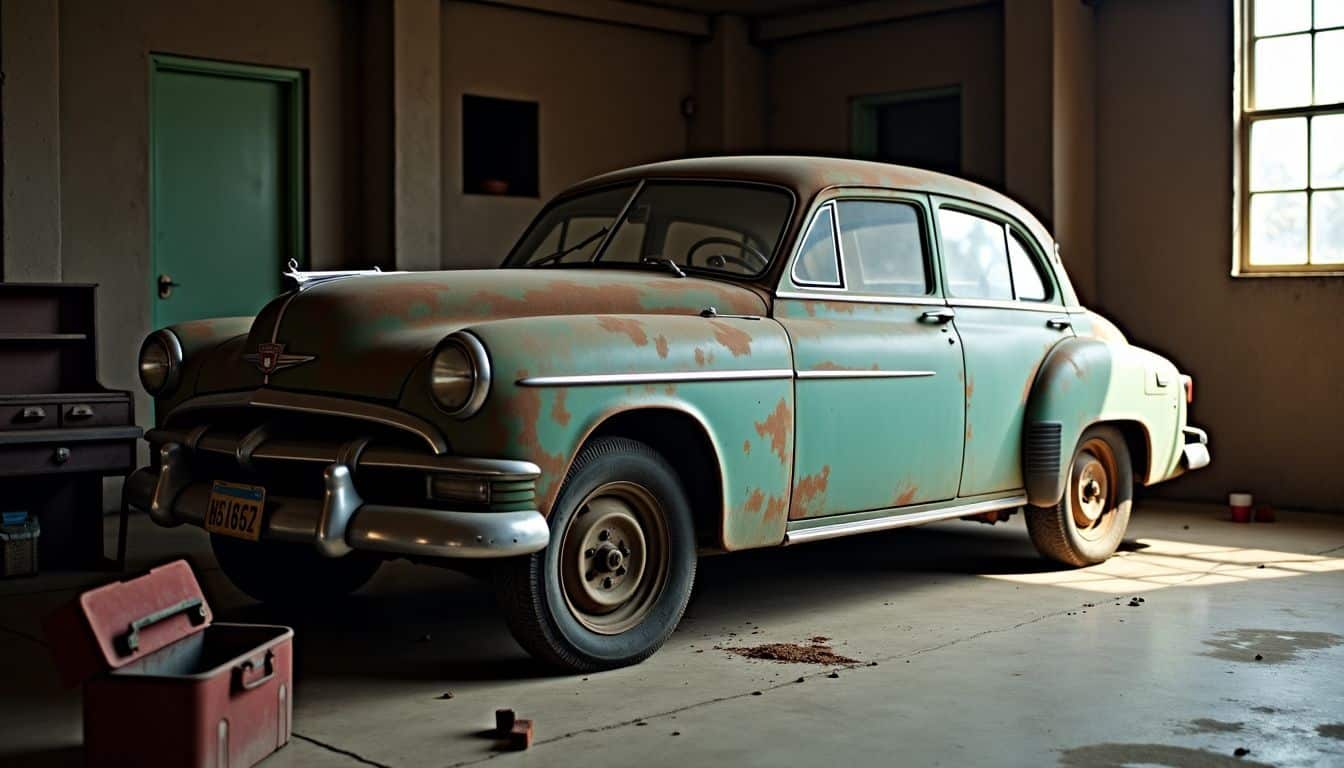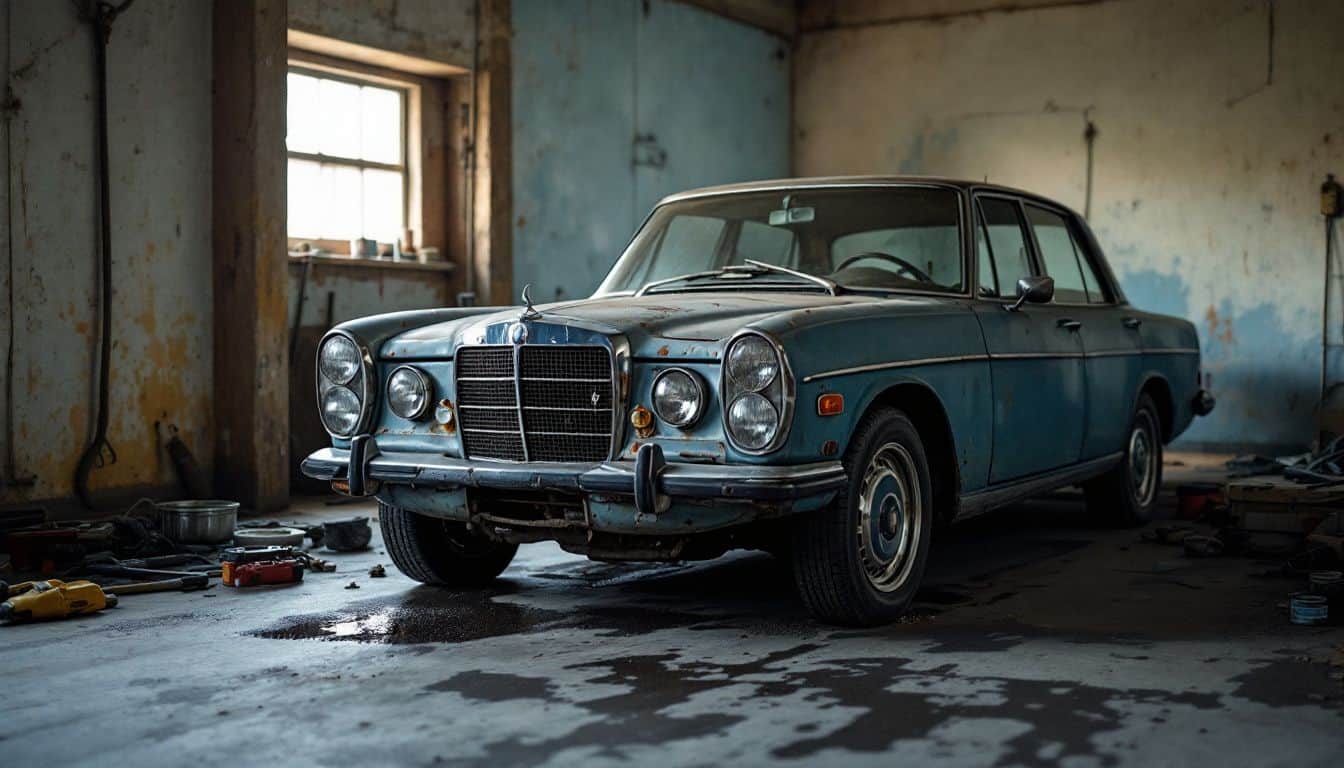Buying a car without breaking the bank feels impossible these days. Car prices have jumped 48% since 2019, making shoppers sweat at dealerships across America. Learning how to buy a car for cheap can save you thousands on your next ride.
Here’s your roadmap to scoring sweet deals on wheels.
Key Takeaways
Car prices have jumped 48% since 2019, with new cars averaging $44,186 and used cars at $25,540 as of March 2024.
The best time to buy a car is between October and December, when dealers offer 10-15% discounts to meet year-end sales targets.
Smart buyers should keep monthly car payments under 10% of take-home pay and set aside 20% of income for maintenance, fuel, and insurance costs.
Toyota Corolla stands out for low depreciation, losing only 24.5% ($5,800) of its value over five years, while fuel-efficient models like the Corolla Hybrid use just $1,500 in gas yearly.
Certified Pre-Owned vehicles offer factory warranties and thorough inspections, while private sellers typically price cars 10-15% below dealership rates.
Table of Contents
Understand the Current Car Market

The car market shifts like a seesaw based on supply and demand. Right now, new cars cost more than ever, which makes used cars a smart pick for budget-minded shoppers.
Assess used vs. new car pricing trends
Ladies, car prices have shifted dramatically in recent years! Smart shoppers need to know current market values for both new and used vehicles. A quick visit to a buy here, pay here dealership can give you real-world insights into local pricing.
| New Cars | Used Cars |
|---|---|
| Average price: $44,186 (March 2024) | Average price: $25,540 (March 2024) |
| Price dropped 3.6% from 2023 | Price dropped 4% from 2023 |
| Higher initial cost | Better value for money |
| Full warranty coverage | Limited or no warranty |
| Latest safety features | Older technology |
| Zero maintenance history | Previous wear and tear |
| 48% price increase over last decade | More negotiation room |
| Higher insurance costs | Lower insurance premiums |
| Rapid initial depreciation | Slower depreciation rate |
Market data shows prices cooling off from their peak. Used vehicles offer significant savings compared to new models. Prices vary by season, with better deals often available during year-end sales events.
Monitor seasonal fluctuations in car prices
Car prices dance up and down like a yo-yo throughout the year. Smart buyers grab their best deals between October and December. Dealerships slash prices during these months to clear their lots for new models.
The drop in prices hits both new and used cars, from sedans to SUVs. Most folks don’t know this secret: dealers offer huge discounts to meet their year-end sales targets.
The market follows a clear pattern each year. Spring brings higher prices as tax refund checks roll in. Summer sees steady prices with occasional dips. Fall marks the start of price drops, especially on current-year models.
Time your car purchase right, and you could save up to 10-15% off the sticker price during end-of-year sales.
Winter, mainly December, offers the deepest discounts on both new and used vehicles. This timing works great for budget-smart shoppers who want to stretch their dollars on fuel-efficient vehicles or electric cars.
Set a Realistic Budget

Money talks, but your wallet needs to do the walking first. A smart budget starts with knowing your monthly income, then subtracting your car payment, gas costs, and maintenance fees from that number.
Determine how much you can afford upfront
Your take-home pay holds the key to smart car buying. A good rule says your monthly car payment should stay under 10% of what you bring home each month. I learned this rule after almost getting stuck with payments I couldn’t handle on my first car.
The Car Affordability Calculator helps you crunch these numbers fast. Your down payment, interest rates, and auto loans all play into this math.
Getting clear on costs upfront saves major headaches later. Think beyond the sticker price and factor in auto insurance, fuel economy, and regular maintenance costs. Last month, my friend Sarah skipped this step and got hit with a $500 monthly insurance bill she hadn’t planned for.
Your credit card or Bank of America statements can help track your current spending to set a realistic car budget. Now let’s look at what ongoing costs you’ll need to plan for with your new ride.
Factor in maintenance, fuel, and insurance costs
The real cost of a car goes way beyond its price tag. Smart car owners put aside 20% of their income for all car expenses. This money covers regular oil changes, tire rotations, and surprise repairs that pop up.
Gas prices swing up and down like a seesaw, so picking a fuel-efficient model like a Honda Accord or Hyundai Elantra saves big bucks. Insurance costs vary based on the car’s safety features and your driving record.
The sticker price is just the tip of the iceberg – maintenance keeps your wheels turning. – Sarah Martinez, Auto Finance Expert
I learned this lesson the hard way with my first car – a luxury model that drained my wallet dry with premium gas and pricey parts. Now I stick to reliable brands with good safety ratings and lower insurance premiums.
The next step is exploring which specific car models hold their value best over time.
Research Affordable Car Models

Smart car buyers know that some models hold their value better than others. You’ll save big bucks by picking cars like the Honda Insight or Subaru Forester, which keep their worth and sip gas like a bird.
Look for cars with low depreciation rates
Cars lose value fast, but some drop less than others. The Toyota Corolla stands out as a smart buy, losing only 24.5% of its value (about $5,800) over five years. This rate beats many other models in the market.
I learned this firsthand after buying three different cars over the past decade.
Your best bet is to focus on models like the Subaru Forester or Honda Insight. These cars hold their value better than luxury brands such as the Audi A4 or Jaguar S-Type. The key lies in picking cars with good fuel economy, solid safety features, and strong reliability scores.
My neighbor’s Forester still fetches 70% of its original price after four years of use.
Focus on fuel-efficient and reliable models
Smart buyers pick fuel-efficient cars that save big money at the pump. The Toyota Corolla Hybrid uses just $1,500 in gas per year, while gas-guzzlers burn through $2,630 annually. My neighbor switched from her old V-8 to a Honda Civic last summer and cut her monthly fuel costs in half.
These reliable models also hold their value better over time, making them a wise choice for budget-conscious drivers.
The cheapest gas is the gas you don’t use. – My mechanic’s golden rule
Fuel-efficient models like the Hyundai Elantra pack modern safety features into their compact frames. The automatic emergency braking and lane departure warning systems make these cars both safe and practical.
The next section discusses why buying used cars might be your ticket to major savings.
Shop for Used Cars

Used cars can save you thousands of dollars on your next ride. Online platforms like Craigslist and Facebook Marketplace offer great deals, while local dealerships often have certified pre-owned options with solid warranties.
Check online platforms like Craigslist or Facebook Marketplace
Online marketplaces like Craigslist and Facebook Marketplace offer great deals on used cars. Smart shoppers meet sellers in public spots and bring a friend along for safety. These platforms let you browse tons of cars from your couch while comparing prices across different areas.
You’ll find everything from hybrid cars to minivans listed by private sellers who often price their vehicles lower than dealerships.
Before meeting any seller, check their profile carefully to avoid a lemon car. Look at their selling history and reviews if available.
The best deals pop up on these sites early in the morning or late at night. Many sellers list their cars with detailed photos, maintenance records, and vehicle history reports. This makes it easier to spot good deals on reliable models like the Ford Escape or Nissan Sentra.
Visit local dealerships with used car inventories
Local dealerships pack their lots with used cars ready for a new home. I spotted great deals at three different lots last week, with prices 10-15% lower than private sellers. Most dealerships put their used cars through basic safety checks and offer short warranties.
The staff can also help you compare different models, like the fuel-efficient Chevy Bolt or spacious passenger vans, right on the spot.
Smart shoppers bring a trusted mechanic to inspect any potential purchase. My friend Sarah saved $2,000 by having her mechanic catch transmission issues before buying. The dealer fixed the problem at no cost since CPO vehicles show 15% fewer problems than regular used cars.
Your next step is exploring certified pre-owned options, which often come with better warranties and perks.
Explore Certified Pre-Owned (CPO) Options

Certified pre-owned cars offer sweet deals with factory-backed warranties and thorough inspections. These cars cost less than new ones but come with perks like roadside help and special financing rates from dealers.
Benefits of CPO vehicles
CPO cars give you the best of both worlds – lower prices than new cars but better quality than regular used ones. These cars pass strict tests for both engine health and looks. Most dealerships offer sweet perks with CPO vehicles, like free oil changes and roadside help.
You’ll also get solid warranty coverage that can save you big bucks on repairs.
A CPO car makes perfect sense if you want peace of mind without breaking the bank. The extended warranties and maintenance plans keep your costs low for years to come. Plus, many CPO programs include vehicle history reports and low-interest financing options.
Next up, let’s check out how car auctions can help you score an even better deal.
Compare warranties and additional perks
Different warranties can make or break your car-buying decision. Smart ladies know the value of good coverage. Here’s a clear breakdown of warranty types and extra goodies you’ll want to check out.
| Warranty Type | What’s Covered | Extra Perks |
|---|---|---|
| Basic Factory | – Engine parts – Transmission – Basic electronics – 3-5 years coverage | – Free oil changes – Basic maintenance |
| Extended Limited | – Major mechanical parts – Some electronic systems – Up to 7 years coverage | – 24/7 roadside help – Rental car coverage – Trip protection |
| Powertrain | – Engine – Transmission – Drive axles – 5-10 years coverage | – Towing services – Travel expense coverage |
| Bumper-to-Bumper | – Most car parts – Interior features – 3-4 years coverage | – Loaner vehicles – Service pickup/delivery – Free maintenance |
| Certified Pre-Owned | – Extended manufacturer coverage – Multi-point inspection – Limited warranty transfer | – Free maintenance – Roadside assistance – Special financing rates |
Consider Auctions and Wholesale Markets

Car auctions offer amazing deals on vehicles that dealers want to move fast. You can save up to 50% off retail prices at wholesale markets, where dealers stock up their own lots.
Public car auctions
Public auto auctions offer great deals on used vehicles. You’ll find cars priced 30-50% below market value at these events. Many local auction houses hold weekly or monthly sales where you can bid on cars from police seizures, bank repos, and fleet vehicles.
I once scored a low-mileage Dodge Caliber for just $3,500 – about half its book value. Just bring your budget in cash and a valid ID to join the bidding action.
Getting ready for an auction takes some prep work to avoid costly mistakes. Check the auction rules and fees on their website first. Most places charge $100-200 for registration using a credit card.
Make sure to arrive early to inspect any cars you want to bid on. Bring a mechanic friend if possible. The next smart step is learning how private sellers can save you even more money on your car purchase.
Dealer-only auctions via brokers
Dealer auctions pack some sweet deals that most folks can’t access directly. RideSafely breaks down this barrier by acting as your proxy dealer. They grab you a seat at these exclusive auto sales, where prices often drop way below retail.
I’ve seen luxury cars sell for 40% less than their market value at these events.
These special auctions offer way more than just basic rides. You’ll spot everything from compact cars to fancy vehicles with all-wheel drive systems. The catch? You’ll pay a broker fee for their help.
But the math often works out in your favor. Last month, my friend Sarah saved $8,000 on a certified pre-owned vehicle through a broker, even after paying their fee. The car came with stability control and fresh headlights – totally worth it!
Negotiate Effectively

Car dealers expect you to haggle, so don’t pay the sticker price. Smart buyers check sites like Kelley Blue Book first, then walk into dealerships armed with competing offers from other sellers.
Research the car’s market value
Smart shoppers check a car’s market value before making any deals. Sites like Kelley Blue Book and NADA Guides show fair prices based on the car’s age, miles, and features. These tools help you spot if a price is too high or if you’ve found a sweet deal.
A quick search tells you what other people paid for similar cars in your area.
Getting the right price means doing your homework on financing rates too. Banks and credit unions offer different interest rates, so shop around for the best deal. Your credit score plays a big part in what rate you’ll get, so check that first.
Many lenders now give pre-approved loans, which puts you in a stronger position to bargain at the dealership.
Use competing offers to leverage better deals
Getting multiple offers puts you in the driver’s seat during car negotiations. I learned this trick while buying my last car – showing the dealer three other quotes made them drop their price by $2,000.
Your goal is to create a sense of competition between sellers. Bring printed quotes from different dealers to your negotiation. Make it clear you’re ready to buy from whoever gives you the best deal.
Tell the dealer straight up that you have other offers on the table. Share the details of competing prices to show you’ve done your homework. Most dealers will try to match or beat other quotes to win your business.
This strategy works great for both new and used cars from dealerships. Now let’s look at how private sellers can help you score an even better deal.
Look for Private Sellers

Private sellers often list their cars for 10-15% less than dealership prices, making them a smart choice for budget-savvy shoppers. You’ll skip the dealer markup and can chat directly with someone who knows the car’s quirks and history, which helps you make a better choice about your next ride.
Advantages of buying directly from owners
Buying straight from car owners puts more cash in your pocket. Most owners price their cars 10-15% below dealership rates, which means big savings for you. You’ll skip those pesky dealer fees and markups that eat into your budget.
Direct owners often share detailed maintenance records and tell you the real story behind every scratch or repair. This open chat makes the whole process less stressful than dealing with high-pressure sales tactics at dealerships.
I saved $3,000 on my Honda by buying from a local teacher who kept perfect service records. The car market in places like Hawaii and Arizona gets even better – you might dodge some sales tax by going the private route.
Plus, owners tend to be more flexible on price and payment terms. You can take your time checking the car and asking questions without feeling rushed. Just bring a trusted mechanic along to inspect before you buy, and you’re good to go.
Tips for inspecting and test-driving
Private sellers offer great deals, but smart inspection habits protect your money. Take a friend who knows cars with you during daylight hours. Check the car’s body for rust spots, dents, or weird paint patches.
Pop the hood and look for oil leaks or strange smells. A clean engine bay shows good care.
Test drives tell the real story of a car’s health. Listen for odd noises from the engine, brakes, or wheels. Try the car on different roads – highways, city streets, and bumpy paths work best.
Test every button, knob, and feature. The air conditioning, radio, and windows must work right. Bad sounds or shakes mean trouble ahead. A smooth, quiet ride points to a good buy. Your gut feeling matters too – if something feels off, walk away.
Take Advantage of Discounts and Promotions

Car dealers slash prices during end-of-year sales to clear their lots for new models. Smart shoppers can grab amazing deals by timing their purchase during major holidays or seasonal clearance events, with savings of up to 10-15% off the sticker price.
End-of-year dealership sales
December brings the best deals at car lots across America. Sales teams push hard to meet yearly goals, which means deeper discounts for you. Most dealerships offer major price cuts, better financing rates, and higher trade-in values during this time.
The rush to clear old inventory makes room for next year’s models.
Smart shoppers grab amazing deals during the final weeks of December. Data shows this timing leads to big savings on both new and used vehicles. You’ll spot special financing deals with low interest rates from banks like Capital One.
Many dealers throw in extras like free maintenance packages or upgraded safety features to seal the deal. The mix of year-end quotas and holiday sales creates perfect timing for budget-conscious buyers.
Manufacturer rebates and incentives
Car makers offer sweet deals to move their vehicles off lots fast. Right now, they spend about $2,808 per car on special offers and cash-back deals. These deals pop up most during major holidays or when dealers need to clear space for new models.
Smart shoppers grab these money-saving chances by checking manufacturer websites and local dealerships for current rebates.
The best part? You can stack different types of savings together. Mix a cash rebate with special financing rates from banks or credit unions. Military members, recent college grads, and first-time buyers often qualify for extra perks.
The key is to ask about every possible discount – from loyalty bonuses to special financing deals. Car prices might seem high, but these manufacturer incentives can knock thousands off your final cost.
Inspect the Car Thoroughly

A professional inspection can save you thousands of dollars by catching hidden problems before you buy. Get a detailed vehicle history report to spot past accidents, repairs, and ownership changes that might affect the car’s value.
Check the vehicle history report
A vehicle history report gives you the full story of any car you want to buy. I learned this after buying my first car without one – big mistake! These reports cost about $25-40, but they save you from costly surprises later.
They show all past accidents, repairs, and how many people owned the car before. Think of it as a background check for your future ride.
Getting this report is super easy through services that track car records. I grab the car’s VIN (that long number on the dashboard) and plug it into their website. The report pops up in minutes with details about insurance claims, service dates, and title changes.
My friend Sarah skipped this step once and ended up with a car that had been in three accidents. Don’t be like Sarah – spend the small cash now to avoid big headaches later.
Conduct a professional inspection
Getting a professional inspection saves you from costly surprises down the road. A pre-purchase inspection (PPI) costs between $100 to $200, which is a small price to protect your investment.
Skilled mechanics check everything from the engine to seat belts during this vital step. They’ll run a vehicle history report and take the car for a test drive to spot any red flags.
Smart buyers never skip the professional inspection before buying a used car. The mechanic looks for hidden problems like drivetrain issues or safety concerns that could cost big money later.
They’ll check the tpms (tire pressure monitoring system) and other crucial parts. This inspection helps you dodge lemons and gives you solid facts for price negotiations with the seller.
Avoid Common Mistakes

Don’t rush into buying a car without checking it first – many buyers skip basic steps and end up with costly repairs. A quick test drive and professional inspection can save you thousands in future maintenance costs, so take your time to spot any red flags before signing those papers.
Don’t skip a test drive
A test drive tells you more about a car than any fancy brochure or sales pitch. I learned this the hard way after buying a used Maxima without proper testing – big mistake! Take the car on both city streets and highways to check its true performance.
Pay close attention to how it brakes, speeds up, and handles different road conditions.
Your test drive needs to cover all driving situations you’ll face daily. Push those brakes firmly, test the acceleration, and listen for weird noises or vibrations. Last month, my friend Sarah spotted a failing transmission during her test drive of a used coupe – that quick spin saved her thousands in future repairs.
The car’s real personality shows up during these drives, from its comfort level to its blind spots.
Avoid overextending your budget
Stick to your budget like glue, ladies! I learned this the hard way after falling in love with a car that ate up my savings. Your monthly car payment should never go above 15% of your take-home pay.
Right now, new cars cost about $48,094 on average – that’s a huge chunk of change! Smart money moves mean looking at your total costs, not just the sticker price.
Money talks, and your wallet needs to listen. Factor in insurance costs, maintenance, and fuel before signing any papers. I’ve seen too many friends get stuck with car payments that left them eating ramen noodles at the end of each month.
Shop around for better interest rates – they hit 5.6% for new cars last August. Your future self will thank you for staying within your means and keeping some cash in your pocket for life’s other fun stuff.
Financing Options for Budget Buyers

Smart buyers get pre-approved loans from credit unions before walking into a dealership. Banks compete for your business, so you can snag lower interest rates by shopping around and comparing offers from different lenders.
Explore pre-approved loans
Pre-approved loans put you in the driver’s seat at dealerships. You’ll get a clear picture of your budget and interest rates before stepping onto the lot. Most banks offer quick pre-approvals in just 60 seconds through their online platforms.
The process needs a hard credit check, but it gives you solid bargaining power with car dealers.
Getting pre-approved means you can shop like a cash buyer. Banks and credit unions compete for your business, which often leads to better interest rates than dealer financing. You’ll avoid the pressure of making rushed decisions about loans in the dealer’s office.
The next step is comparing interest rates from different lenders to find your best deal.
Compare interest rates from banks and credit unions
Credit unions offer better deals on car loans than banks right now. The numbers tell the story – credit unions charge 6.36% interest on 60-month new car loans, while banks ask for 7.39%.
That 1% difference might seem small, but it adds up to big savings over time. Credit unions also make it easier to get approved with less strict credit rules.
Smart shoppers check rates at multiple places before signing any papers. Local credit unions often beat the big banks on car financing deals. They care more about helping members save money than making huge profits.
Plus, credit unions give the same great rates to most members, unlike banks that save their best deals for perfect credit scores.
Consider Leasing Instead of Buying
Leasing a car can slash your monthly payments by up to 30% compared to buying. You’ll get to drive a new car every few years with lower repair costs, but you’ll need to watch those mileage limits and keep the car in good shape.
Pros and cons of leasing
Car leasing feels like renting a fancy dress – you get to drive a new car without the huge upfront costs. Monthly payments stay lower than buying, and you’ll dodge most repair bills since the car stays under warranty.
The sweet spot? You can swap your ride every few years for the latest model.
The flip side hits your wallet harder than you’d think. Those monthly payments never stop, unlike a car loan that ends once you’ve paid it off. I learned this the hard way after signing a three-year lease – the total costs ran higher than if I’d bought the car outright.
Plus, strict mileage limits mean you’ll pay extra fees if you drive too much. You’re also stuck paying for full coverage insurance, which adds up fast.
Look for lease takeover deals
Lease takeover deals offer a smart way to snag a great car at lower monthly payments. You’ll step into someone else’s lease agreement and take over their remaining payments, often at better rates than a new lease.
Many people need to exit their leases early due to job changes or moves, creating perfect opportunities for savvy shoppers. The best part? You’ll dodge the hefty down payment that comes with starting a fresh lease.
These deals pop up on sites like LeaseTrader and SwapALease, where you can browse tons of options. The monthly costs stay the same as the original lease, but many desperate sellers offer cash incentives to take over their payments.
You’ll need good credit and must pass the leasing company’s approval process. The perks include shorter commitment times and access to newer models without the typical upfront costs.
Just check the remaining mileage limits and make sure the car fits your needs before jumping in.
Save on Insurance Costs
Smart car insurance shopping starts with comparing rates from at least five different companies. You’ll save big bucks by picking a higher deductible and bundling your car insurance with other policies like home or renters insurance.
Compare quotes from multiple providers
Shopping for car insurance rates takes time, but the savings make it worth every minute. Getting quotes from at least three different insurance providers helps you spot the best deals and coverage options.
Many drivers save up to 30% on their premiums by comparing multiple quotes before picking a policy. Top insurance companies offer special discounts if you bundle your auto coverage with other policies like home or life insurance.
Your driving record plays a huge role in what you’ll pay for coverage. Insurance providers look at your safety record and claims history to set your rates. Safe drivers with clean records often qualify for big discounts that can cut their premiums by hundreds each year.
The key is to gather quotes from both large national insurers and smaller regional companies to find the sweet spot between good coverage and affordable rates.
Opt for higher deductibles to lower premiums
After comparing insurance quotes, you can slash your costs even more. Picking a higher deductible on your car insurance drops your monthly premiums big time. I learned this trick when I switched my deductible from $500 to $1,000.
My insurance costs fell by 30% right away.
Safe drivers benefit most from higher deductibles. The math is simple – you pay less each month but take on more risk if you need to file a claim. My clean driving record made this choice easy.
Just make sure you have enough savings to cover that higher deductible if you need it. Your bank account should have at least the deductible amount tucked away for peace of mind.
People Also Ask
What’s the best way to save money when buying a car?
Look for cars that don’t depreciate quickly, like hybrids or electric vehicles. Compare insurance costs and maintenance costs up front. Check MSRP against actual prices, and watch for supply chain issues that might affect costs.
Should I get a loan or pay cash for my car?
Consider options like a HELOC, line of credit, or traditional lending. Watch interest rates from The Federal Reserve. If using financing, check offers from banks like Citi or American Express. A lump sum payment might save money on variable-rate loans.
Which car types are cheaper to own long-term?
Hatchbacks and wagons often cost less than coupes. Look at miles per gallon for gas cars or miles per gallon equivalent for battery electric cars. Factor in electricity prices for plug-in hybrid vehicles.
How important is car safety when buying cheap?
Very! Check crash ratings and vehicle safety features. Models like the Subaru XV Crosstrek Hybrid or Infiniti G35x offer good safety without breaking the bank. Don’t skimp on safety to save money.
What should I know about financing a car?
Watch your debt-to-income ratio. Compare checking account offers and money market rates. Get fact-checked info about taxes and fees. Remember, financed cars need full insurance coverage.
Are electric and hybrid cars really cheaper?
While charging infrastructure costs matter, all-electric and flex fuel vehicles often save money long-term. Cars like the Scion tC or models with i-VTEC or Quattro systems balance performance with cost. GMC cargo vans might cost more upfront but last longer.
References
https://www.bankrate.com/insurance/car/car-value-statistics/
https://www.webuyanycarusa.com/blogs/view/the_seasonality_of_car_prices
https://www.nerdwallet.com/article/loans/auto-loans/much-spend-car
https://www.caranddriver.com/features/g28592010/fun-affordable-appeciating-cars/
https://cars.usnews.com/cars-trucks/advice/cars-with-the-slowest-depreciation (2024-07-23)
https://www.bankrate.com/insurance/car/buying-a-car-on-facebook-marketplace/ (2025-01-21)
https://www.consumerreports.org/cars/how-to-get-a-great-deal-on-a-used-car-a1053499625/ (2024-08-27)
https://www.bobbyrahalacura.com/the-benefits-of-buying-a-certified-preowned-vehicle.htm
https://www.nerdwallet.com/article/loans/auto-loans/certified-preowned-cars (2025-01-11)
https://www.lendingtree.com/auto/how-to-buy-a-car-at-auction/ (2024-03-29)
https://auction.ridesafely.com/maximize-savings-dealer-auctions-guide/
https://www.mdpi.com/2071-1050/14/15/8993
https://www.cliffsnotes.com/study-notes/22266727
https://privateauto.com/buy/why-is-it-better-to-buy-from-a-private-seller
https://www.nerdwallet.com/article/loans/auto-loans/tips-for-buying-a-used-car-from-a-private-seller (2022-05-17)
https://caredge.com/guides/best-time-to-buy-a-car-2024
https://www.nerdwallet.com/article/loans/auto-loans/find-car-incentives (2024-03-14)
https://www.ffuncars.com/images/ckfinder/FFUN%20Car%20Buying%20Guide.pdf
https://moneywise.com/loans/auto-loans/tips-for-buying-a-car-on-a-budget
https://www.consumerreports.org/cro/2012/12/10-common-car-buying-mistakes/index.htm
https://www.lendingtree.com/auto/pre-approved-car-loan/
https://www.investopedia.com/credit-union-vs-bank-auto-loan-what-s-the-best-choice-7556622
https://www.consumerreports.org/cars/buying-a-car/leasing-vs-buying-a-new-car-a9135602164/ (2024-09-29)
https://www.usnews.com/insurance/auto
https://www.nerdwallet.com/article/insurance/save-money-car-insurance (2024-06-21)
